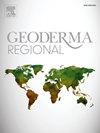乌克兰草原低强度土地利用区黑钙土腐殖质形态、蚯蚓生物扰动与土壤有机碳储量
IF 3.1
2区 农林科学
Q2 SOIL SCIENCE
引用次数: 0
摘要
乌克兰草原地带低强度土地利用系统的黑土地是可持续发展的一个重要因素,有助于保护自然资源和维持农业生产力与环境保护之间的平衡。本研究的目的是评估在不同类型植被(荒地、防护林和原生森林)的影响下,乌克兰草原带低强度土地利用系统的黑钙土的腐殖质状态。腐殖质状态由腐殖质形态、蚯蚓扰动强度、土壤有机碳(SOC)含量和储量、SOC/clay比值等特征决定。根据腐殖质系统和腐殖质形态分类键对腐殖质形态进行分类。蚯蚓铸体的含量在薄片中以表面层2-0.25 mm部分团聚体总数的百分比计算。采用滴定法测定土壤有机碳,并计算其在土层中的储量。土壤有机碳/粘粒比是测定土壤结构质量等级和腐殖质饱和度的指标。采用统计学方法(描述性统计、方差分析/方差分析、根据Tukey标准的多重均值比较)比较不同植被类型影响下土壤的数量特征。结果表明,野生黑钙地的土足类属于中腐殖类,防护林和原生林下的土足类属于低腐殖类。原生森林黑钙土蚯蚓粪含量分别是野生草原和人工森林黑钙土的3.5倍和2.9倍。原生林的有机碳/粘土比(p小于0.05)在统计学上显著高于荒地和防护林的指标。建立了土壤有机碳储量在土壤厚度上的分布与植被类型的依赖关系,其中原生林的有机碳储量分别是林地和防护林的1.42倍和1.40倍,差异有统计学意义(p小于0.05)。因此,在低强度土地利用条件下,植被类型显著影响乌克兰草原带黑钙土的腐殖质数量、质量和整体腐殖质状态。这项研究的结果将有助于诊断有机质转化,计算乌克兰草原土壤中的碳储量,以及监测农业中积极使用的黑钙土的腐殖质状态。本文章由计算机程序翻译,如有差异,请以英文原文为准。
Humus forms, earthworm bioturbation and soil organic carbon storage in Chernozems of the low-intensity land use of steppe zone of Ukraine
Chernozems of the low-intensity land use systems of the steppe zone of Ukraine are an important factor of sustainable development, contributing to the conservation of natural resources and maintaining a balance between agricultural productivity and environmental protection. The aim of the study was to assess the humus state of Chernozems of the low-intensity land use systems of the steppe zone of Ukraine under the influence of different types of vegetation (Wildland, Shelterbelts and Native forest). The humus state was determined by such characteristics as humus forms, intensity of earthworm bioturbation, content and reserves of soil organic carbon (SOC), SOC/clay ratio. Humus forms were classified according to Keys of classification of humus systems and forms. The content of earthworm casts was calculated in thin sections as a percentage of the total number of aggregates of the 2–0.25 mm fraction of the surface layer. Soil organic carbon was determined by the titration method, with subsequent calculation of its reserves in the soil layer. The SOC/clay Ratio was used to determine the soil structure qualities class and the level of soil layer saturation with humus. The comparison of quantitative characteristics of soils under the influence of different types of vegetation was carried out by statistical methods (descriptive statistics, ANOVA/MANOVA, multiple comparison of means according to the Tukey criterion). It was found that humipedons of Wildland Chernozems belong to the Mesomull humus form, humipedons under Shelterbelts and Native forest belong to Oligomull. Earthworm casts content in Native forest Chernozem is 3.5 and 2.9 times higher than in Chernozems under wildland steppe vegetation and artificial forest, respectively. SOC/clay Ratio for Native forest statistically significantly (p ˂ 0.05) exceeds the indicators for Wildland and Shelterbelts. The dependence of the distribution of SOC reserves in the thickness of the studied soils on the type of vegetation was established, according to which the SOC reserve for Native forest statistically significantly (p ˂ 0.05) exceeds this indicator for Wildland and Shelterbelts by 1.42 and 1.40 times, respectively. Thus, the type of vegetation significantly affects the quantity, quality of humus and the overall humus state of Chernozems of the steppe zone of Ukraine under low-intensity land use. The results of the study will be useful for diagnosing organic matter transformations, accounting for carbon reserves in soils of steppe landscapes of Ukraine, and monitoring the humus state of Chernozems that are actively used in agriculture.
求助全文
通过发布文献求助,成功后即可免费获取论文全文。
去求助
来源期刊

Geoderma Regional
Agricultural and Biological Sciences-Soil Science
CiteScore
6.10
自引率
7.30%
发文量
122
审稿时长
76 days
期刊介绍:
Global issues require studies and solutions on national and regional levels. Geoderma Regional focuses on studies that increase understanding and advance our scientific knowledge of soils in all regions of the world. The journal embraces every aspect of soil science and welcomes reviews of regional progress.
 求助内容:
求助内容: 应助结果提醒方式:
应助结果提醒方式:


